Archivo de noticias y eventos
701 - 750 de un total de 2402
También puede acceder a la lista de noticias publicadas en los medios relacionadas con el Instituto de Astrofísica de Andalucía - CSIC.
Pages
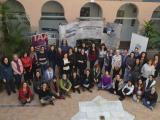
|
10/02/2020
Día Internacional de la Mujer y la Niña en la Ciencia El Instituto de Astrofísica de Andalucía se suma a la celebración del Día Internacional de la Mujer y la Niña en la Ciencia, que busca visibilizar la labor científica de las mujeres y fomentar las vocaciones en las niñas |

|
06/02/2020
La misión Solar Orbiter despega hacia su órbita alrededor del Sol La misión, que observará el Sol desde una perspectiva sin precedentes, estudiará tanto la física solar como la influencia del Sol en el medio interplanetario. El Instituto de Astrofísica de Andalucía (IAA-CSIC) colidera SO/PHI, el mayor de los diez instrumentos a bordo de la misión |

|
23/07/2020 - 12:30
X-ray Astronomy for non (X-ray) astronomers Observations of X-rays coming from outside the solar system were pioneered in 1962 by Riccardo Giacconi and colleagues. From that very day, it became evident that X-rays would reveal a very different Universe to that shown by optical or radio telescopes. Indeed, X-rays are typically produced in the environment of black holes, or where the ambient temperature exceeds millions of degrees. X-ray telescopes (which, for good reason, are in orbit)... Dr. Xavier Barcons |

|
25/06/2020 - 12:30
Peering into the Dark: Probing the Formation and Early Evolution of Massive Stars This presentation will focus on recent work aimed at understanding the formation and early evolution of massive protostars. The massive (M>8 Msol) stars into which these evolve are the primary drivers of galactic ecosystems. The energy and nuclear processed material these massive stars inject into their enviroment during their lives and ultimately as supernovae, shapes the physical and chemical evolution of the ISM in galaxies. These stars... Dr. Gary Fuller |

|
14/05/2020 - 12:30
Gamma-ray Emitting Narrow Line Seyfert 1 Galaxies: Past, Present, & Future The detection of significant gamma-ray emission from about a-dozen radio-loud narrow line Seyfert 1 (NLSy1) galaxies by Fermi-Large Area Telescope has opened up a realm to explore the physical conditions needed to launch relativistic jets in a different central engine and host galaxy environment than that is known for more-common jetted active galactic nuclei, i.e. blazars. Promising results acquired from various multi-wavelength campaigns are... Dr. Vaidehi S. Paliya |

|
10/09/2020 - 12:30
SO Web-loquio: Massive black hole binaries in the cosmos Massive black holes weighing from a few thousands to tens of billions of solar masses inhabit the centers of today's galaxies, including our own Milky Way. Massive black holes also shone as quasars in the past, with the earliest detected a mere one billion years after the Big Bang. Along cosmic time, encounters between galaxies hosting massive black holes in their centers have produced binary massive black holes that eventually coalesced by... Dr. Marta Volonteri |

|
18/02/2020 - 12:30
Evolution of statistical techniques in Astronomy The requirement for more robust statistical tools is becoming increasingly higher owing to the demands of various large programmes and the technological advancement producing high-sensitive observations across the electromagnetic spectrum. Among the many existing analyses, the ones working on the time-series as set by the monitoring projects using single-dish/optical telescopes and those of spectral-line observations as rendered by ALMA/IFUs are... Dr. Venkatessh Ramakrishnan |

|
04/06/2020 - 12:30
TuMaG: un magnetógrafo para Sunrise III After the scientific success of the two first flights of the Sunrise stratospheric balloon mission, the international consortium led by MPS (Göttingen, Germany) decided to re-issue the mission for a third time. For Sunrise III, a new gondola and navigation system will be provided by APL (Johns Hopkins University, MD) and the re-furbished telescope by MPS. The latter also provides the instrumental platform and the light distribution system while... Dr. José Carlos del Toro Iniesta |

|
30/01/2020
Pedro Duque expresa un compromiso firme con el programa de excelencia Severo Ochoa Pedro Duque expresa un compromiso firme con el programa de excelencia Severo Ochoa |
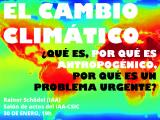
|
30/01/2020 - 19:00
El cambio climático, ¿qué es, por qué es antropogénico y por qué es un problema urgente? El cambio climático, ¿qué es, por qué es antropogénico y por qué es un problema urgente? Rainer Schödel |

|
18/06/2020 - 12:30
Exploring the origin of gas-rich ultra-diffuse galaxies with HI kinematics Ultra-diffuse galaxies (UDGs) are one of the most discussed topics in extra-Galactic astronomy in the last lustrum given their puzzling properties: they have luminosities typical of dwarf galaxies, but optical scale lengths similar to very massive spirals. This intriguing combination is hard to explain, and up to date the precise formation mechanism of UDGs remains unknown. With the goal of learning more about their origins, our group has... Pavel E. Mancera Piña |

|
20/02/2020 - 12:30
YOUNG RUNAWAY STARS Most stars have spatial velocities within a few km/s of the average velocity of their surroundings and can be considered to be gravitationally trapped. There are, however, a small number of stars that move at velocities of tens or even hundreds of km/s with respect to their environment and that will eventually escape from there. The archetypal runaway stars are mu Col and AE Aur that escaped in opposite directions from the vicinity of the Orion... Dr. Luis Felipe Rodriguez |

|
11/02/2020 - 12:30
Experiments with MUSE data: Finding SN remnants & other curious sources One of the ways of following up on the success story of CALIFA is to refine the spatial resolution, and MUSE is the tool for that. Its superb image quality allows for a different kind of science. While browsing through emission line images derived from MUSE datacubes, we have spotted a number of compact-looking sources with forbidden line emission ([OIII], [NII], [SII]) in excess of that typical of HII regions. NGC 4030, a late type spiral 30... Dr. Roberto Cid Fernandes |

|
04/02/2020 - 12:30
Cosmic butterflies: the product of tempestuous stellar marriages Planetary nebulae are some of the most strikingly beautiful astrophysical phenomena known, gracing many a glossy-paged, coffee-table book and earning them the nickname "cosmic butterflies". Classical stellar evolutionary theory states that all intermediate mass stars should produce a planetary nebula, forming as the star leaves the Asymptotic Giant Branch and evolves towards the white dwarf phase. While it remains the standard for astronomy... Dr. David Jones |
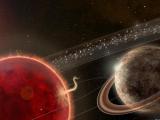
|
15/01/2020
Se hallan indicios de la existencia de un segundo planeta en torno a Próxima Centauri, la estrella más cercana al Sol Con una masa mínima de unas seis veces la terrestre, el planeta giraría en torno a la estrella a 1.5 veces la distancia entre la Tierra y el Sol. Este estudio se suma a trabajos anteriores que apuntan a la existencia de un sistema planetario complejo en torno a Próxima Centauri |

|
30/07/2020 - 12:30
SO Webloquio:The Orion Radio All-Stars: new insights into YSO radio emission, using the VLA, VLBA, and ALMA With significant new observing capabilities, centimeter-wavelength radio astronomy is currently in a renaissance leading up to the advent of the Square Kilometre Array (SKA), highlighting new opportunities and also technical challenges. The sensitivity upgrades of both the NRAO Very Large Array (VLA) and the Very Long Baseline Array (VLBA) have begun to provide us with a much improved perspective on stellar centimeter radio emission,... Jan Forbrich |

|
19/03/2020 - 12:30
Study on astrophysical masers in the era of SKA/SKA-VLBI In my colloquium talk, out of the introduction topics mentioned above, I will focus my talk on trigonometry of maser sources yielded with the Square Kilometre Array (SKA) Phase 1. This is one of the science cases that have been planned as Japanese scientific contributions to SKA1. Its key issue is the scientific and technical feasibility in the low frequency band, corresponding to SKA1-MID Band 2 around 1.6 GHz, in which atmospheric effects on... Dr. Prof Hiroshi Imai |

|
31/01/2020 - 12:30
NoiseChisel and Gnuastro: non-parametric detection and analysis of astronomical targets Astronomical instrumentation has greatly advanced over the last 40 years: with digital detectors, space telescopes and +8m class ground-based telescopes for example. However, the signal-based detection paradigm (for example from Petrosian or Kron in the 1970s, mostly used as implemented in SExtractor from the mid-1990s) is still the dominant method of low-level data analysis: detection, segmentation and measurements or catalog production. In... Dr. Mohammad Akhlagh |
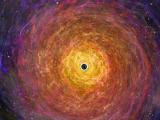
|
20/12/2019
La imagen del agujero negro de M87 el hito científico más relevante del año La revista Science ha seleccionado la primera imagen de un agujero negro como el hito científico más relevante del año. |

|
09/01/2020 - 12:30
Galaxy evolution and weak lensing studies in the J-PAS survey During the next year, the J-PAS survey will start imaging the northern sky with a unique photometric system composed of 56 narrow and 4 broad bands. The peculiar configuration and strategy of this survey pursue to provide accurate low-resolution spectra or photo-spectra (FWHM~125 \AA) allowing us to obtain high-quality photometric redshifts (\sigma_z~0.003 for LRGs) for millions of galaxies across 8000 deg^2 of the sky. Recently, the J-PAS... Dr. Luis Díaz García |
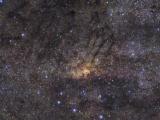
|
16/12/2019
Investigadores del IAA descubren un episodio extremadamente violento en la historia de la Vía Láctea, con más de cien mil explosiones de supernova Un muestreo con una resolución sin precedentes de las regiones centrales de nuestra galaxia revela su historia completa de formación estelar, que presenta abruptos altibajos en la formación de estrellas. Se hallan indicios de un estallido de formación estelar tan intenso que originó más de cien mil explosiones de supernova |
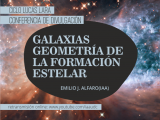
|
19/12/2019 - 19:00
Galaxias. Geometría de la formación estelar Conferencia de divulgación Emilio J. Alfaro |

|
27/02/2020 - 12:30
Proper motion study of the Galactic Centre Stellar proper motion studies in the centre of the Milky Way have been typically limited to the Quintuplet, Arches, and central parsec clusters. In this talk, I will present the primary results of a large-scale proper motion study of the central ~ 36' x16' of the Galaxy based on our GALACTICNUCLEUS survey (epoch 2015) combined with the HST Paschen-alpha survey (epoch 2008). This region of our Galaxy is not covered sufficiently by the existing... Dr. Banafsheh Shahzamanian |
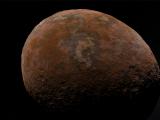
|
11/12/2019
Se hallan indicios de la existencia de un satélite alrededor de Varuna, un cuerpo menor situado más allá de Neptuno Quince años de observaciones desde distintos telescopios, entre ellos los del Observatorio de Calar Alto y del Observatorio de Sierra Nevada, han permitido detectar la señal de una luna en torno a este objeto transneptuniano |

|
10/12/2019
Se observa el acercamiento de las estrellas de un sistema binario debido a la emisión de ondas gravitatorias El sistema está compuesto por dos estrellas enanas blancas que giran en torno al centro de masas común cada veinte minutos, y que van acercándose gradualmente. El trabajo, en el que participa el Instituto de Astrofísica de Andalucía (IAA-CSIC), muestra que las estrellas se han “achatado” y presentan forma elipsoidal debido a las fuerzas de marea |

|
19/12/2019 - 12:30
The SKA precursor telecope MeerKAT as a galaxy evolution explorer MeerKAT is a radio telescope situated in South Africa's Karoo desert. It has recently been built as an SKA demonstrator and precursor telescope and was inaugurated in August 2018. Since then it has proven to be the world's most sensitive 20cm interferometer and is slowly moving towards standard operation. Thanks to its array layout MeerKAT is a superb telescope to observe in particular the HI line, hence tracing the most abundant atom in its... Dr. Józsa Gyula István Géza |
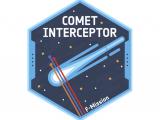
|
04/12/2019
El IAA participa en Comet Interceptor, la nueva misión de la ESA para estudiar un cometa prístino El Instituto de Astrofísica de Andalucía (IAA-CSIC) colabora en el desarrollo de cuatro de los nueve instrumentos a bordo de la misión |

|
05/03/2020 - 12:30
Round Table: Dia de la Mujer To be provided Round Table |

|
02/12/2019
Hallan una estrella que oculta, entre sus pulsaciones, fulguraciones millones de veces más intensas que las del Sol Observaciones con el satélite Kepler permiten hallar actividad superficial en estrellas en las que, según los modelos teóricos, no debería producirse. En la muestra destaca la estrella KIC 9716385, que presenta, ocultas entre sus pulsaciones, fulguraciones millones de veces más intensas que las solares |

|
30/01/2020 - 12:30
Mirror-slicer Array for Astronomical Transients. A new Integral Field Spectroscopy mode for OSIRIS at GTC MAAT (Mirror-slicer Array for Astronomical Transients) is proposed as a new mirror-slicer optical system that will allow the OSIRIS spectrograph at the 10.4 m GTC the capability to perform integral-field spectroscopy (IFS) over a seeing-limited field of view 14.20’' x 10'' with a slice width of 0.303''. MAAT will enhance the resolution power of OSIRIS by 1.6 times with respect to its 0.6'' wide long-slit. All the eleven OSIRIS grisms and VPHs... Dr. Francisco Prada |

|
05/12/2019 - 12:30
Gaia mapping mission and science of Solar System Objects I will present the generalities of the Gaia surveying mission, and current status. I will then discuss the improvement brought by Gaia over its 5 years and more of mission—starting with DR1—for the science of asteroids and other SSOs; and focusing especially on the astrometry and dynamics of asteroids. After reminding generalities on SSO observations by Gaia - and some of their peculiarities, we present some of the advances obtained from the... Dr. Daniel Hestroffer |

|
25/11/2019
El IAA se suma a la lucha contra la violencia de género El personal del centro se ha concentrado a las puertas del instituto para denunciar la violencia de género |

|
10/12/2019 - 12:30
SO-IAA Colloquium: Unveiling the nature of planetary systems The burgeoning field of exoplanets has yielded thousands of discoveries, which collectively have the potential to help us better understand our place in the Universe. Every month more and more planetary systems are being discovered,some of them in highly exotic configurations never observed previously. The combination of different techniques and studies are needed to unveil the real nature of these planetary systems. In this seminar, I will... Dr. Francisco Pozuelos |
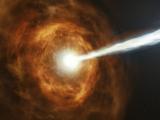
|
20/11/2019
El colapso de una estrella bate los récords en producción de fotones de muy alta energía Los telecopios MAGIC, en la isla de La Palma, detectan fotones en el rango de los teraelectronvoltios en una explosión de rayos gamma (GRB), producto de la muerte de una estrella muy masiva. La detección, que requiere contemplar nuevos mecanismos en la producción de energía en los GRBs, aporta una perspectiva fundamental para completar nuestra compresión sobre estos eventos |
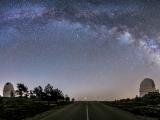
|
02/03/2020
Grandes cartografiados y nueva instrumentación para el observatorio de Calar Alto El observatorio de Calar Alto abre un llamamiento para nuevos proyectos de intrumentación |

|
28/11/2019 - 19:00
Si no podemos salvar Galápagos, ¿qué podemos salvar? Conferencia de divulgación Silbia López de Lacalle |

|
13/02/2020 - 12:30
From protostars to planets: the astrochemical link Protostars accrete their material from the natal cloud through accretion disks. These disks are progressively dispersed by the recently formed star to form protoplanetary discs in which planets are born. Although this process takes a few million years, now we think that the final chemical composition of the gas and dust in the proto-planetary disk is to a large extent determined by the chemical evolution in the natal cloud. Determining the... Dr. Asunción Fuente |

|
07/11/2019
Una compañera invisible podría explicar la fuerte emisión de rayos X de la Nebulosa del Esquimal Un grupo de astrónomos internacional liderado por el Instituto de Astrofísica de Andalucía encuentra una variación periódica en la emisión en rayos X de la estrella central de la Nebulosa del Esquimal |

|
26/11/2019 - 12:30
Inverse Compton emission revealed by observations up to TeV energies of GRB 190114C The hunt for Gamma-Ray-Bursts (GRBs) at very high energy (VHE) started more than 20 years ago. A hint of emission was already claimed by Milagrito from the observations of GRB 970417. On 19 of January the Major Atmospheric Gamma Imaging Cherenkov (MAGIC) clearly detected GRB 190114C above 0.2 TeV. This is the first highly significant detection (over 50sigma reached in the first few tens of minutes after the burst) of a GRB at VHE. GRB190114C... Dr. Elena Moretti |

|
23/01/2020 - 12:30
SO Colloquia: Extragalactic survey science in the 2020s: the role of radio continuum observations with the SKA Extragalactic surveys in the 2020s will reveal the full diversity of the galaxy assembly process: from environment-dependent evolution to the build-up of mass inside galaxies, and with a complete accounting of all relevant processes/constituents ensured by multi-wavelength coverage. Observations at radio wavelengths carry a unique potential in that they can probe star-formation activity and cold gas content, i.e. place constraints on both galaxy... Mark T. Sargent |

|
15/01/2020 - 12:30
Public Surveys and new instrumentation for Calar Alto Observatory The Calar Alto observatory (CAHA) is a key institution for the international astronomical community, for its highly competitive astronomical facilities (telescopes and instrumentation). From 2019 on, the current administration of CAHA includes the Junta de Andalucía as a new partner – replacing the Max Planck Gesellschaft -, and together with the Spanish National Research Council (CSIC) these two institutions manage the operation of the... Dr. Jesus Aceituno |
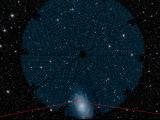
|
28/10/2019
Cinco mil ‘ojos’ para capturar los colores del cosmos El Instrumento Espectroscópico para el estudio de la Energía Oscura (DESI, por sus siglas en inglés) ha realizado hoy su primera observación de prueba |

|
31/10/2019 - 00:15
Ahora en serio: ¿hay alguien más ahí fuera? Juan Carlos Suárez |

|
23/10/2019
El IAA obtiene un Accésit del Distintivo de Igualdad del CSIC El distintivo tiene como objeto promover la perspectiva de género en el CSIC |
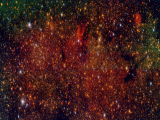
|
14/10/2019
Investigadores del IAA logran el catálogo de estrellas más detallado del Centro Galáctico El proyecto Galacticnucleus permitirá estudiar la población estelar que rodea al agujero negro supermasivo del Centro Galáctico con un detalle sin precedentes |

|
06/02/2020 - 12:30
SO Colloquia: Extrasolar planets: recent advances and future challenges Recently a group of scientists has confirmed the presence of water in the atmosphere of a super Earth orbiting in the habitable zone of its host star. But what what does this milestone represent in the search for life outside Earth? What do we mean by habitable? What do we really know about extrasolar planets, their internal structure or origins? What is a super Earth, the most common planet category know to date for which no example is found in... Dr. Juan Cabrera |
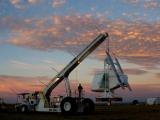
|
06/10/2019
El espejo de la misión SUNRISE, que estudiará el Sol desde un globo estratosférico, se pone a punto en Calar Alto El espejo de SUNRISE, de un metro de diámetro, se somete al proceso de aluminizado como parte de los preparativos para el próximo vuelo de la misión |

|
29/10/2019 - 12:30
Nebular HeII emission from spatially resolved metal-poor star-forming galaxies Nebular HeII1640,4686 emission, observed to be more frequent in high-z galaxies than locally, is indicative of far harder ionizing spectrum than that seen in nearby systems. Star-forming galaxies with lower metal content tend to have a larger nebular HeII intensities compared to those with higher metallicities. This agrees with the expected harder spectral energy distribution at the lower metallicities typical in the early universe. Theoretical... Dra. Carolina Kehrig |
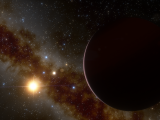
|
26/09/2019
CARMENES halla un anómalo sistema planetario que desafía nuestra comprensión de cómo se forman los planetas CARMENES halla un anómalo sistema planetario que desafía nuestra comprensión de cómo se forman los planetas |

|
04/10/2019 - 12:30
Cúmulos Jóvenes: eclosionando, moviéndose, volando En las últimas dos décadas, nuestro conocimiento de los cúmulos estelares jóvenes, ha progresado rápidamente del uso de imágenes estáticas con cada vez mayor calidad, hacia mapas de movimientos en seis dimensiones (posiciones, velocidades), que están cambiando muchas de nuestras ideas de cómo los cúmulos estelares surgen de los complejos de nubes moleculares. Conforme nos movemos de escalas de parsecs a hectoparsecs, ahora vemos a los cúmulos... Dr. Carlos G. Román Zúñiga |